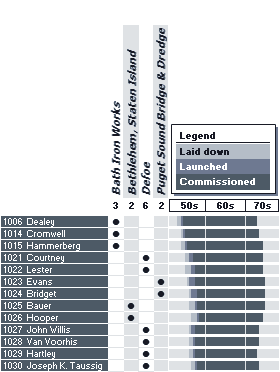

Design work began in September 1949 with a John C. Butler-class destroyer escort arrangement. Intended for mass production if rapid mobilization were needed, design criteria for this “first generation” of post-World war II destroyer escort included a low silhouette and low center of gravity, low cost and a small crew. While steam turbine machinery was retained, a single screw prevented the need for two powertrains. When the final Dealey design emerged a year later, its flush-deck profile combined influences of a World War II DE hull with aspects of the bow and aluminum superstructure of the Forrest Sherman class soon to come.
Authorized and laid down in 1952, the lead ship was followed by two sisters authorized in F/Y 1953, two in ’54 and eight in ’55 for a total of thirteen. With 20,000 shp, the prototype reached 27½ knots on trials and commissioned in November 1954. Dealey carried four 3-inch/50 caliber dual purpose guns in twin mounts: one with a gun house forward and one unshielded aft. She alone initially carried a British Squid ASW mortar; her twelve sisters, completed by four shipbuilders over a three-year time span, mounted Weapon Alfa. Both were later deleted. The class also completed with a single depth charge track aft and six projectors. Initially, their sonar was the then-powerful new SQS-4 (also fitted in the World War II classes and the Mitschers).
Length: 315' overall; 308' waterline.
Beam: 36' 8".
Draft: 11' 10".
Displacement: 1,314 long tons light; 1,877 long tons full load.
Propulsion machinery: 20,000 shp; 1 shaft.
Design speed: 27 knots.
Design complement: 12 officers; 161 enlisted.
The Dealeys proved seaworthy—worthy upgrades of the World War II DE classes, with twin rudders that made possible a tight turning radius—but they were modestly equipped in light of the Soviet submarine threat they faced. Accordingly, as a part of the Fleet Rehabilitation and Modernization (FRAM) program of fiscal year 1962, ten ships (excluding Dealey, Cromwell and Courtney) received the more advanced SQS-23 sonar (also installed in the Charles F. Adams class) with its massive 20-foot diameter transducer and 10,000 yard direct path detection range, plus a DASH unmanned helicopter system with a sonobuoy capable of delivering the Mk 46 homing torpedo.
Their US Navy careers were short, however, thanks to the introduction of the LAMPS Mk I Seasprite manned helicopter in 1972 for the mass-produced Knox class frigates that could carry it. That year, Dealey was transferred to Uruguay and Hartley to Colombia. The other eleven ships were stricken by August 1974, having been in commission for only 16–19 years.
Sources: Bauer & Roberts, Friedman, Silverstone.